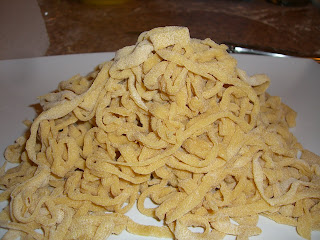Today's post is all about delicious yet easy to make preserved foodstuffs!
First up is pickled daikon radishes and carrot. Tasty on their own, but most likely to be eaten in conjunction with other things, pickled daikon can be found as the tasty bit of acidic crunch in Vietnamese banh mi. Banh mi are amazing to me, perfect sandwiches, with an ideal balance of flavors and textures when done well--tender bread with a bit of crisp on the outside, tasty meats on the inside, pickled daikon and cilantro and jalapenos on the inside. The pickles brighten up the flavors of the sandwich and offer a counterpoint to what can be a rich meat filling, not to mention again that delightful crunch. It's amazing what a big difference one ingredient can make to a dish.
 Deliciously full, big jar of pickled radishes and carrots.
Deliciously full, big jar of pickled radishes and carrots.
See, I knew there was a good reason to keep my giant
kimchi jars around long after the kimchi was gone.
But I digress. I first made these with the intention of making some of my own banh mi, which I did, but also realized how tasty they can be eaten on their own and in other dishes--see my previous post on pork belly buns, for a delightful example. There they acted as a perfect acidic and textural counterpoint to the richness and tenderness of the pork.
Pickled radishes are simple to make. Cut them up into the desired length and thickness - often done slightly larger than julienned - and make the brine. The brine is incredibly easy and simple too - a little salt and sugar, water, and white vinegar and you're done. After the vegetables have had some time to bathe in the brine, they'll emerge nicely crunchy, a little sour, and a little sweet. Delicious!
Next, preserved lemon. I hadn't heard of these before, but I was attracted to a lovely picture in a cookbook which was simply lemons in a jar with kosher salt and some lemon juice and decided I had to make these--so that I, too, could have a pretty jar of preserved lemons in my fridge.
 Preserved lemon after being removed from the brine and rinsed off.
Preserved lemon after being removed from the brine and rinsed off.
I have another giant kimchi jar with the remaining lemons pickling
in their brine, but they're no longer in the state where I could have
taken some pretty pictures of the jar. Shame on me!
The idea is to cut lemons (Meyer or regular, I used Meyer) into quarters vertically, without cutting all the way through so that the quarters are still attached to one another on one end, then pack the cavity of the lemon with kosher salt. Put those lemons all together in a jar, squeeze some additional lemon juice over the top and put the jar in the fridge. During the next couple of weeks, the jar should be accumulating juice as the flesh of the lemons break down.
I know next to nothing about Moroccan cooking, but apparently these are quite the magic ingredient in many a Moroccan dish and introduce an intense lemony, somewhat salty flavor that is quite different from using a fresh lemon. For the most part you'll be using only the rind of the lemon - after rinsing the lemon off.
 A sampling of the finished iced sugar cookies I made for
A sampling of the finished iced sugar cookies I made for









